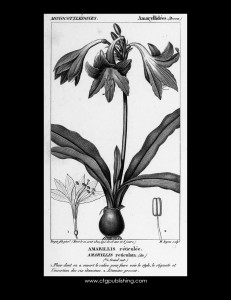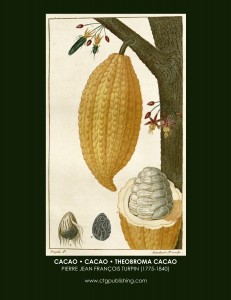Pierre J.F. Turpin Biography
Born: Vire, Calvados, France on 11 March, 1775
Wife: Marie-Louise-Agathe (b. Chatel) Turpin
Son: Pierre-Jean-Frédéric-Eugène Turpin (1803-1821)
Died: Paris, May 2, 1840
Elected: Académie des Sciences in 1833
Pierre Jean François Turpin was a botanist and artist who travelled, collected plants and studied nature to a microscopic level. He translated this knowledge into illustrations that are presented in some of the most important botanical works of his day. It is believed that he produced over 6,000 water-color paintings on vellum. Although it is stated that he was mostly a self-taught artist, he did have formal training in Vire by, most likely, the Delavente brothers. In 1808, Jean-François Delavente (1746-1812) painted several portraits of the Turpin family including images of his wife and son.
At the age of 14, Turpin enlisted as a soldier and served during the revolution. In 1794, he travelled to Santo Domingo (Haiti) with his battalion where he studied nature and met the botanist, Pierre-Antoine Poiteau (1766 – 1854). He returned to France with his battalion but found his way back to Santa Domingo through an appointment as an illustrator for Sorel, the Chief Engineer at Port-au-Prince. After a few months, he travels to Cap-Français and joined Poiteau who introduces him to the French. U.S. consul, Edward Stevens. Stevens funded Poiteau and Turpin’s expedition to Tortuga. Turpin stayed for over a year to collect and study plants but the political instability escalated and he decided to follow Poiteau to the United States.
He arrived in New York and then traveled to Philadelphia where he met Alexander von Humboldt with whom he returned to France in 1802. I that same year, General Leclerc appointed Turpin as the army apothecary for his expedition but it is unclear if Turpin accepted since the expedition concluded unsuccessfully that same year. In 1803, his son, Pierre Jean Frédéric Eugène Turpin, was born.
 Turpin produced many works with a list provided below. One of these works was the Dictionnaire des sciences naturelles that also included over 35 illustrations by his son, Pierre Jean Frédéric Eugène Turpin. His son died in 1821 at the age of 18. The plate included along side this paragraph is his son’s work. His father inscribed the work, crediting his son with a remark on his passing. The museum in Vire also has an addition inscription on the back of the original plate and one other housed at the museum. The inscription reads as follows:
Turpin produced many works with a list provided below. One of these works was the Dictionnaire des sciences naturelles that also included over 35 illustrations by his son, Pierre Jean Frédéric Eugène Turpin. His son died in 1821 at the age of 18. The plate included along side this paragraph is his son’s work. His father inscribed the work, crediting his son with a remark on his passing. The museum in Vire also has an addition inscription on the back of the original plate and one other housed at the museum. The inscription reads as follows:
« This original illustration, painted by Pierre Jean Frédéric Eugène Turpin, a few days before his death, is part of the collection included in the atlas of the Dictionnaire des sciences naturelles of Levrault. The illustrator, who was 18 years and 6 days of age, ceased to live on the 21st of August 1821. »
Turpin continued to produce works throughout his life, was elected to the Académie des Sciences in 1833 and died in Paris in 1840 at the age of 65.
List of Works
- Esquisse D’organographie Végétale, Pierre Jean François Turpin, A. Cherbuliez, 1837
- Flore médicale décrite par MM. Chaumeton, Poiret, Chamheret, Imprimerie de C.L.F. Panckoucke, 1832
- Mémoire sur l’organisation intérieure et extérieure des tubercules du solanum tuberosum et de l’helianthus tuberosus. Paris, 1828
- Observations sur quelques végétaux microscopiqueslues à l’Académie des sciences de l’Institut, en sa séance du 12 juin 1824. Parts, de l’impr. de Belin, 1827
- Flora Brasiliae meridionalis /auctore Augusto de Saint-Hilaire ; accedunt tabulae delineatae a Turpinio aerique incisae, Parisiis :Apud A. Belin,1825-1833
- Manuel de malacologie et de conchyliologie par H. M. Ducrotay de Blainville. Paris,F. G. Levrault,1825-1827
- Icones selectae plantarum quas in systemate universali, Parisiis :[Apud Fortin Masson et Sociorum] 1820-1846
- Leçons de flore Paris :C.L.F. Panckoucke, 1819-1820
- Dictionnaire des sciences naturelles, Cuvier, Frédéric, Strasbourg,||Paris,F. G. Levrault;||Le Normant, 1816-1830.
- Flore parisienne, contenant la description des plantes qui croissent naturellement aux environs de Paris, Schœll, 1808-13. [Only 9 copies were sold with the 68 plates].
- Plantes équinoxiales recueillies au Mexique, Voyage de Humboldt et Bonpland, Paris, Schoell, 1808-09
- Choix de plantes dont la plupart sont cultivées dans le jardin de Cels par E.P. Ventenat. Paris, Crapelet,an 11, 1803.
- Annales Muséum d’histoire naturelle
- Tom. V, 1804
Description d’une nouvelle espèce de Thouinia, 2 pl.
Observations sur les Rhu aromaticum et suaveolens, 1 pl. - Tome VII, 1806
Castella. Polygamie monœcie, Lin., 1 pl.
Mémoire sur l’organe par lequel le fluide fécondant peut s’introduire dans l’ovale des végétaux, 1 pl.
Cypsefa , nouveau genre de la famille des portulacées , 1 pl.
- Tom. V, 1804
- Mémoires du Muséum d’histoire naturelle
- Tome III, 1817
Lettre à M. le bar. de Beauvois, relative à sa Notice préliminaire sur les palmiers, insérée dans la première livraison du premier volume des Éphamérldes des sciences naturelles , 1 pl. - Tome V, 1819
Mémoire sur l’inflorescence des graminées et des cypérées , comparée avec celle des autres végétaux sexifères , suivi de quelques Observations sur les disques, 2 pl. - Tome XIV, 1827
Organographie végétale. Observations sur quelques végétaux microscopiques, et sur le rôle important que leurs analogues joueut daus la formation etl’accroissement du tissu cellulaire, 1 pl.
- Tome III, 1817
CTG Publishing has published many of Pierre Jean François Turpin’s botanical plates focusing on his herb and spice botanical illustrations.
The below are the botanical subjects for the illustrations included in the delsc edition dedicated to Pierre Jean François Turpin.
| English Name | French Name | Scientific Name |
| Almond | Amande | Prunus dulcis |
| Anise | Anis | Pimpinella anisum |
| Banana | Banane | Musa |
| Basil | Basilic | Ocimum basilicum |
| Cacao | Cacao | Theobroma cacao |
| Caper | Caprier | Capparis |
| Caraway | Carvi | Carum carvi |
| Cardamom | Cardamome | Amomum |
| Carob | Caroubier | Ceratonia siliqua |
| Cashew | Cajou | Anacardium occidentale |
| Chamomile | Camomille | Matricaria recutita |
| Chestnut | Marron | Castanea |
| Chevril | Cerfeuil | Anthriscus cerefolium |
| Cilantro (Coriander) | Coriandre | Coriandrum sativum |
| Cinnamon | Cannelle | Cinnamomum |
| Cloves | Clou de girofle | Syzygium aromaticum |
| Coffee | Café | Coffea |
| Cumin | Cumin | Cuminum cyminum |
| Curly Mint | Menthe Crispée | Mentha spicata |
| Date | Datte | Phoenix dactylifera |
| Dill | Aneth | Anetheum graveolens |
| Fennel | Fenouil | Foeniculum |
| Garlic | Ail | Allium sativum |
| Ginger | Gingembre | Zingiber officinale |
| Ginseng | Ginseng | Panax |
| Juniper | Génévrier | Juniperus |
| Lavender | Lavande | Lavandula |
| Lemon | Limon | Citrus ×limon |
| Licorice | Réglisse | Glycyrrhiza glabra |
| Mace | Macis | Myristica fragrans |
| Mustard | Moutarde | Sinapis hirta |
| Nutmeg | Noix de Muscade | Myristica fragrans |
| Onion | Oignon | Allium cepa |
| Oregano | Origan | Origanum vulgare |
| Parsley | Persil | Petroselinum crispum |
| Pepper | Poivre | Piper nigrum |
| Peppermint | Menthe Poivrée | Mentha ×piperita |
| Pineapple | Ananas | Ananas comosus |
| Pistachio | Pistache | Pistacia vera |
| Rosemary | Romarin | Rosmarinus officinalis |
| Saffron | Safran | Crocus sativus |
| Sage | Sauge | Salvia |
| Star Anise | Anis étoilé | Illicium verum |
| Sugar | Sucre | Saccharum |
| Thyme | Thym | Thymus serpyllum |
| Tumeric | Curcuma | Curcuma longa |
| Vanilla | Vanille | Vanilla |
| Walnut | Noix | Juglans |
Resources
- Musée botanique de M. Benjamin Delessert, Antoine Lasègue, 1845
- Biographie universelle ou Dictionnaire historique par une société de gens de lettres, Furne, 1841 Réunion des sociétés des beaux-arts des départements, Vol. 13, 1889
- Archives de l’art français, Société de l’histoire de l’art français, 1889
- Dictionnaire général des artistes de l’école française depuis l’origine des arts du dessin jusqu’à nos jours, Renouard, 1885
- La France litteraire, ou dictionaire bibliographique, J.-M. QUERARD, 1838
- Les Aristes Peintres et scupteurs de la ville de Vire, A. FEDERIQUE, http://histoiredevire.fr, accessed Nov 14, 2012

